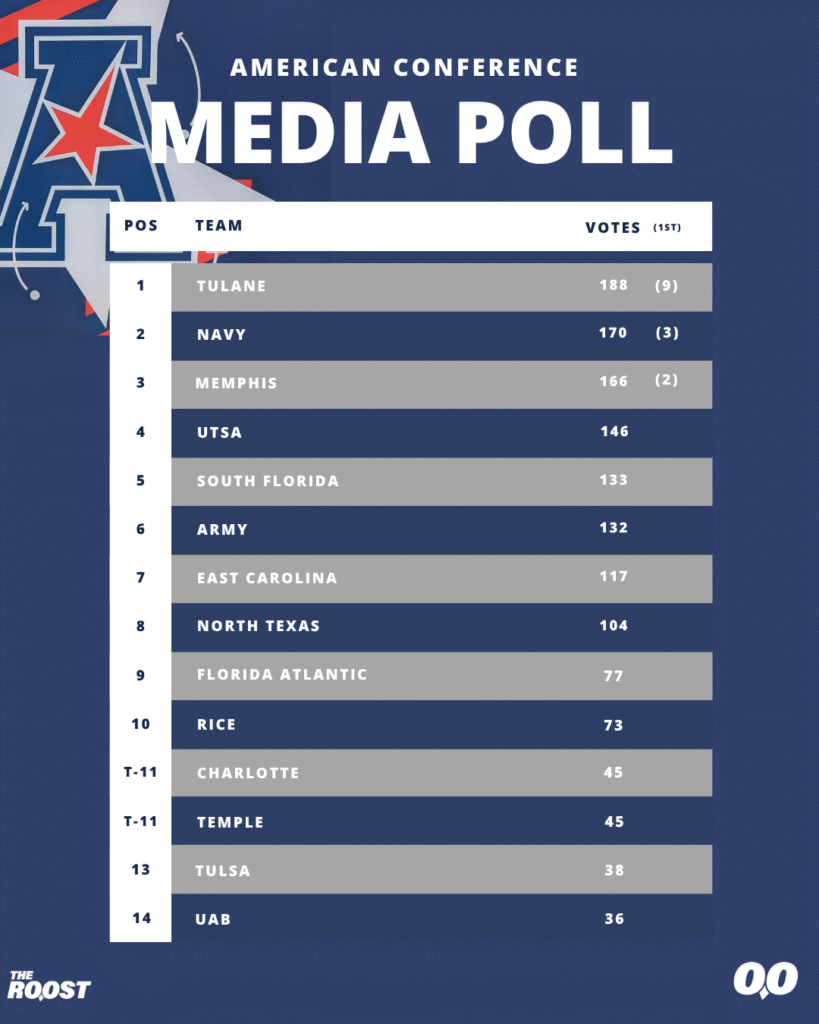American Conference Media Days were held this week in Charlotte, NC. Here’s a roundup of important news, quotes and insights from the event.
In Their Own Words

.@RiceFootball head coach Scott Abell describes his offensive philosophy:
— The Roost (@AtTheRoost) July 25, 2025
"We're going to run the football. My programs have led the country at all levels in rushing… We're going to run the rock, creatively." pic.twitter.com/ZMsxWwyuMP
.@RiceFootball head coach Scott Abell on why he did not bring players with him from Davidson, like has become more common in today's world of college football.
— The Roost (@AtTheRoost) July 25, 2025
"I think it's important to immediately establish your roots there." pic.twitter.com/us1gsGnwTf
.@RiceFootball head coach Scott Abell on the unique variations between his offense and the option offenses at Army and Navy:
— The Roost (@AtTheRoost) July 25, 2025
"We are wildly unique when you look at the different systems… We're all three different and how teams have to defend us is going to be different." pic.twitter.com/aSsJgMu453
With three options teams in the conference now, Army head coach Jeff Monken weighed in on the schematic similarities.
— The Roost (@AtTheRoost) July 25, 2025
"It's now going to create in the league the need for defensive coordinators and defensive staffs to come up with an option plan." pic.twitter.com/icBF9mFrbj
UTSA head coach Jeff Traylor on Jon Kay, another Texas High School Football Coach, becoming a defensive coordinator this offseason for @RiceFootball.
— The Roost (@AtTheRoost) July 25, 2025
"It doesn't surprise me at all that he's in that role and I promise you they'll playing really good defense." pic.twitter.com/sHFW4DO4AB

AMERICAN CONFERENCE MEDIA DAYS | It was a short walk from the designated media hotel to the Charlotte Convention Center, just a few blocks in what turned out to be a sunny, beautiful summer day in the Queen City. Along the path was the Hilton Charlotte Uptown Hotel, the host of the ACC — not to be confused with the conference formerly known as the AAC — Media Days.
Outside of the Hilton were three giant letters, A.C.C., a clear identifier of who was on campus and what was happening inside those revolving doors. A little further down the street was the convention center, which had a graphic for the American Conference Media Days rotating on the large digital sign on the outside of the building.
One step inside those doors, however, and all the eye could see was pink. Mary Kay Pink, to be specific.

Hosted in the same building and dominating the air, the Mary Kay Seminar included hundreds of attendees, all pink-clad with signs and logos everywhere. There were no visible signs for the American, the American Conference, the AAC or any other iteration of the namesake of the league ostensibly holding court in the very same building.
Two separate venue attendants, when I stopped to ask for directions to the American event, did not know what I was referring to or where the event was being held.
During a week meant to set the conference apart as distinctive, modern, and unique, simply my arrival at the conference’s flagship event was marked by external noise.
That’s the real challenge this conference faces right now. It’s not just a name — the conference issued new brand guidelines this past week — it’s relevance in an ever-changing landscape marked more by turnover and inconsistency than anything else. For better or worse, the conferences the American would call its peers have identities formed over years of like membership, longstanding rivalries and tradition. How do you manufacture that in 2025? It’s hard.
When commissioner Tim Pernetti took the podium, he was bold, direct and assertive. “A brand is more than a logo,” he said, describing his league as leaders, not followers, multiple times throughout his address.
Pernetti pointed towards the conference’s brand ambassador, Soar the Eagle, the first such character at the college football level. He mentioned the league’s willingness to explore new ventures, to challenge perceived norms and call out parts of the college sports world right now that simply aren’t working.
“We’re not waiting for this industry, in case you haven’t noticed,” Pernetti quipped. “We’re building it. We’re leading it, strategically, and with purpose and thought along the way.”
At the same time, Pernetti’s conference eliminated its standard preseason media poll, following in the steps of the Big 12, which did the same thing, despite previously acknowledging plans to conduct the poll. The league will also introduce player availability reporting, adopting a policy similar to that of the autonomy league’s which began doing those a year ago.
Whether through originality or adaptation, the American believes it is doing all it can to differentiate itself from the hundreds of college programs and dozens of conferences across the country, a seemingly increasingly more challenging prospect with each passing year.
On the field, they’ve fared well, producing three 10+ win teams a year ago and having multiple teams in the College Football Playoff conversation late in the season. Army was ranked inside the Top 25 for a large portion of the regular season. Memphis finished as a Top 25 team. When it comes to making a name for itself on the gridiron, this is a conference that has done its part.
“Line up. Play the games. Let’s see where the chips fall at the end of the year,” Pernetti advocated, pushing for access to the College Football Playoff and multiple at-large spots.
To be fair to the league, so many of the factors that drive culture and brand identity exist beyond its control. But fairness has never been something with which college sports have ever really concerned themselves. No, the American must do the best it can with the cards it has been dealt and find a way to stand out, from all-pink convention centers to the college football world, at large.

In what has turned out to be a rather eventful week for the American Conference, The Roost reported Monday that the league intended to do away with its preseason media poll. The American did not return a request for comment as to why this long-standing tradition was being dropped.
In response, The Roost gathered a representative sample of media members to conduct our own poll, including representation from all 14 programs. Here are the results, with first-place votes in parentheses:

Following a runner-up finish in 2024, Tulane has been named the favorite in 2025. They edge out Navy and Memphis, the only other teams to receive first-place votes. East Carolina is the only program with a new head coach to crack the top half of the poll, coming in at seventh. Florida Atlantic, Rice, Charlotte, Temple and Tulsa bring up the next group of new coaches in their first year in the league.
When asked for comment as to why the league abruptly stopped the poll, commissioner Tim Pernetti called it an “industry-wide trend” although at this point, the American marks just the second of 12 conferences to step away from an annual preseason poll of this sort.
Pernetti went on to elaborate, saying, “The reason we’re moving away from this now, I think it’s more difficult to actually put your finger on how this should look, given that rosters look dramatically different every year. The transfer portal has created a lot of uncertainty and chaos.”



In recent memory, expectations have, quite literally, never been higher for Rice football. The 2024 AAC Media Poll, released during Media Days on Tuesday morning, projected Rice to finish seventh in the 14-team conference. Not only is that higher than the Owls’ were picked last year (12th), but it’s also higher than any team head coach Mike Bloomgren has coached at South Main thus far.
“To see us tied for seventh, I guess that’s improvement,” head coach Mike Bloomgren said. “But again, that’s not where I think we should be with our team and what this coaching staff and these players have built together collectively.”
Rice was never picked to finish higher than second from the bottom in the West in Conference USA’s divisional structure. In 2021, the Owls’ only year in the league without divisions, Rice was tabbed to finish 10th. For this program to overcome outside perceptions and get recognition in the middle of the pack is not insignificant. The five-spot rise is the second biggest of any team in the AAC. South Florida was the only other program in the league to climb more than two spots, moving from 13th to fourth.
Rice has been a program content to play the underdog role as they’ve built from a two-win season in 2018 to back-to-back bowl campaigns in their most recent seasons. They aren’t the favorites just yet, but those outside of South Main clearly don’t view this program as a perennial underdog any longer.
No longer is this a team expected to finish in the bottom view. First impressions might not change quickly, but something has certainly shifted when it comes to the perception of Rice football around the AAC.
The players inside the locker room have noticed the shift, too. “Talking together as a group, we feel like we should be in the championship conversation,” proclaimed veteran safety Gabe Taylor. “We can’t make no excuses this year. We have to learn how to win and make sure we take care of business one week at a time.”
At the end of the day, media polls are worth the paper they’re printed on. Outside prognostications don’t determine the actual order of finish, that’s what the games are for. And until you start winning those games with regularity, those polls will likely be a lagging indicator of the quality of the program you’ve built. Seventh is better than tenth, but it’s a far cry from first. There is work left to be done.
“I think that’s a good thing. I think the less eyes that are on us the better,” said running back Dean Connors.” We fuel off the underdogs. We have a lot of guys that weren’t highly recruited. The longer we stay like that, the better.”
If things go according to plan, Rice football might not be flying under the radar for much longer.

